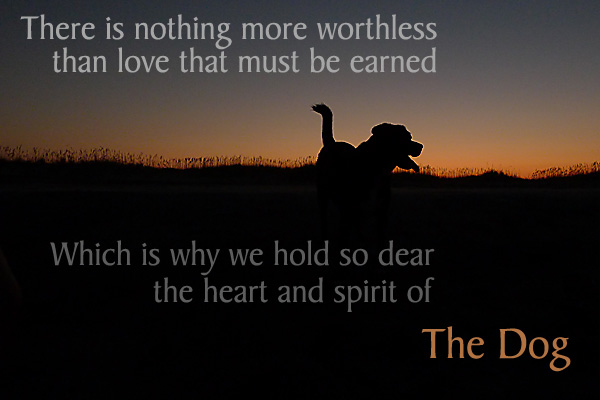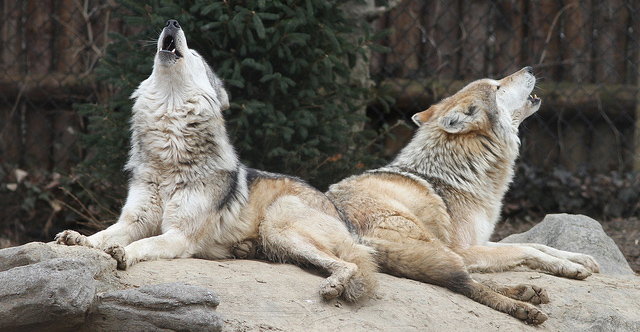
Is My Dog a Wolf in Dog’s Clothing?
The challenge with contrasting wolf and dog behavior is twofold. First, most wolf behavior studies have been conducted on wolves living in captivity; however, captive wolves behave quite differently than wolves living in the wild with little or no human contact. The assumptions made about wolf behavior based on captive wolves, may not be entirely accurate. Secondly, the process of domestication itself changed many wolf-like behaviors as hundreds of breeds were developed over time for a wide range of purposes. As we know, domesticated dogs come in a vast number of shapes, sizes and colors with various skill sets and temperaments.
One theory about how our ancestors helped to domesticate dogs suggests they kept and influenced the breeding of the most docile wolves in order to create the qualities we most enjoy in our pet dogs today. They desired wolves that could be easily led and trained, were less aggressive, more social and were not fearful of man. Wolves that were less likely to challenge man’s leadership could be more easily trained to perform a task or become a friendly companion. Interestingly, those desired qualities are found in wolf pups. Neoteny is a term that describes adult animals that evolve to retain many of their juvenile traits, which is what our ancestors have created with the modern day dog, a wolf that has retained its pup-like qualities. Dogs traits such whining, barking, submissiveness, playfulness and being free of fear exist in wolf pups, but are rarely observed in adult wolves. Even the physical wolf pup traits of having smaller and shorter teeth, less powerful jaws and shorter muzzles are found in most domesticated dogs.
So, your dog may not be a wolf in dog’s clothing, but there is a little bit of the wolf in each of our dogs, a wolf pup that is!
Bret Michaels, Rockin’ Pet Accessory Designer
Yes, he’s a rocker, but there’s a lot more to the Poison frontman Bret Michaels than you may realize. His wide range of titles include singer, songwriter, musician, actor, director, producer, winner of Celebrity Apprentice 3 and more recently, pet accessory designer. Huh? Yes, Bret Michaels has been busy designing his Pets Rock Collection of toys, collars, leashes, apparel, beds, bowls and of course, bandanas, sold exclusively at PetSmart stores.
Bret has always had a close relationship with his pets and they each hold a special place in his heart, especially a Siberian Husky named Nicholas who may have saved his life by alerting his manager during an episode when his blood sugar level had dropped dangerously low. He currently owns two German Shepherds named Diesel and Phoenix along with a couple of horses and his pet rats, Harley and Charlie. It’s no wonder Bret has a strong love of dogs and is excited to put his energy into this project.
As if we didn’t have enough reasons to like and respect the rocker, Bret recently made a generous donation to Canine Companions for Independence, a non-profit organization that provides trained assistance dogs to returning veterans and people with disabilities.
If you want your pet to rock out with some of Bret’s affordable, rock-themed accessories, head to your nearest PetSmart store or order online. My personal favorite is the Ballistic Arm Squeaker Dog Toy, but look for new additions to his line this summer and a line of cat toys called Look what the cat dragged in coming this fall.
10 Tips Before You Start Training Your Dog
 So, you got a new puppy in the home or just adopted an adult dog. Don’t worry if you have a couple of chewed up shoes or a few spots on the carpet, now is the perfect time to turn things around and get started on your dog training routine. Training your dog doesn’t have to be just another chore added to your long list of things to do. It only takes a few minutes out of your day and you’ll have fun watching your new dog learn commands as she works hard to please you. In the end, you can sit back, relax and be proud while you enjoy your well-behaved dog. In the meantime, here are some tips before you start training your dog that will make the process go a lot smoother.
So, you got a new puppy in the home or just adopted an adult dog. Don’t worry if you have a couple of chewed up shoes or a few spots on the carpet, now is the perfect time to turn things around and get started on your dog training routine. Training your dog doesn’t have to be just another chore added to your long list of things to do. It only takes a few minutes out of your day and you’ll have fun watching your new dog learn commands as she works hard to please you. In the end, you can sit back, relax and be proud while you enjoy your well-behaved dog. In the meantime, here are some tips before you start training your dog that will make the process go a lot smoother.
Having a positive attitude towards training you dog can make the process easy and enjoyable. Yes, even when she grabs that hamburger off the kitchen counter, it’s an opportunity for training. Be patient and consistent and your dog will be soon rewarding you for all your hard work.
For Love of the Dog – Building Love, Trust and Respect
 Ironically, the same three characteristics that make for healthy human relationships are vital to creating a positive relationship between you and your dog. Love, trust and respect. Developing these qualities will not only make your life a lot easier, but you’ll end up with a happy, well-adjusted dog that loves, trusts and respects you as well.
Ironically, the same three characteristics that make for healthy human relationships are vital to creating a positive relationship between you and your dog. Love, trust and respect. Developing these qualities will not only make your life a lot easier, but you’ll end up with a happy, well-adjusted dog that loves, trusts and respects you as well.
Send your comments about how building love, trust and respect play a role or influence the relationship you have with your dog.

